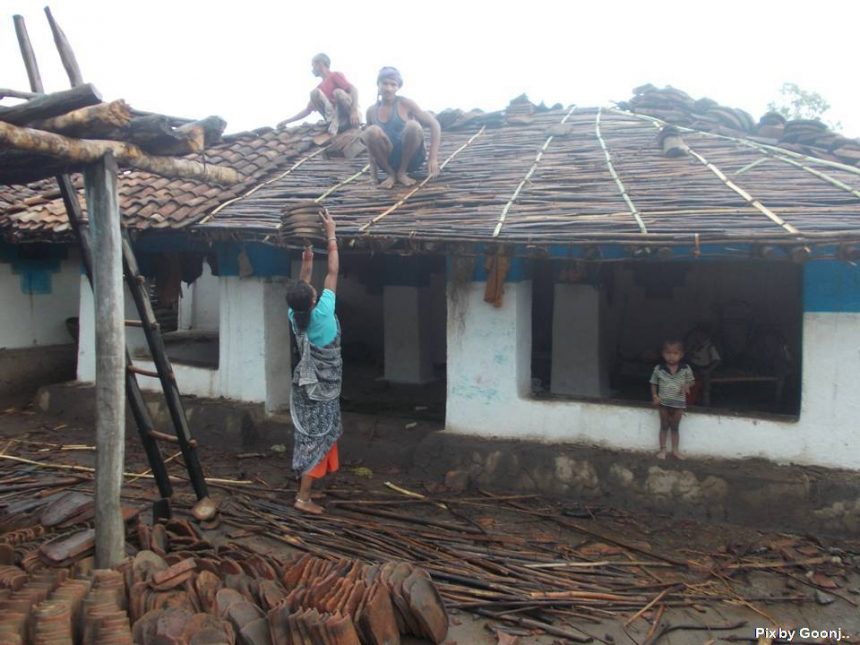Over the years Goonj has grown organically from an idea to a pan India organization. Like us this story irrevocably underlines how material.. old material at that.. instead of money, can be a instigator, motivator and a powerful source of innovative development work for anyone feeling constrained by lack of funds.
This story is about Uttara and Mandla and how our second lab of deep rooted innovations grew and blossomed with material.
48 years old Uttara runs a grassroots organization in Mandla district of Madhya Pradesh. Mandla is a tribal district in the east-central part of Madhya Pradesh. Like most parts of MP Mandala is endowed with dense forests and numerous rivers including the world famous Satpura Tiger Sanctuary and Kanha National Park. Dominated by Baigas, Gonds, Abhujhmarias, Bharias, Hill Korwas and Soharias tribes Mandla also has the unflattering distinction of being one of the most backward districts of the state.
Stricken with extreme poverty, ignorance and diseases the area is under the siege of severe malnutrition. For Mandla and for the rest of the world Uttara stands testimony to how dreams can turn into a reality. Reforming acres of land, building a school under “Cloth for work‟ (CFW), turning the tide of migration, ensuring everyone in her village has a Sujni‟ in winters, Prayas Shiksha Samiti Mandla (an active partner of Goonj) run by Uttara made thousands of people in her area realize their own potential.
It all started with Uttara‟s dream to have a school in her village.. With very little at hand, she ran her makeshift school sometimes from an open Haat area or at some abandoned structures or anywhere where she could make her children sit. With fifteen kids enrolled; mostly orphans and dropouts, she approached anyone who gave her a patient hearing.. Her efforts got her 2 chairs, 2 registers, 1 water tank, a broom and a clock from the local Gram panchayat. Uttara recalls how she bought chuna and mitti to make an abandoned structure fit for her school. With no doors to safeguard the little they had, every day she would take all the school material to a nearby govt. hospital for safekeeping. In the morning her first task used to be to clean all the mess made by the village cattle in the door less rooms and campus. Soon Uttara got her school registered by the name of Rani Durgawati School even though it was still running on makeshift facilities. She put all her resources in buying a piece of land for Rs 15,000, arranging 20 gunny bags of cement, 2000 bricks and for the gate (Iron Doors) for the school. By this time the resources for the labor for constructing the school proved to be a stumbling block even for Uttara.
Coincidently this is when she got introduced to Goonj through our nationwide initiative School to School. This was back in 2009, when her school strength was 50 with 2 additional teachers whose salaries she could hardly manage.
This still left the issue of labor for constructing the school. The truck load of material sent to Uttara, consisting of tables, chairs, doors and windows along with a lot of clothes proved to be game changer in this. After distributing half the clothes to the villagers Uttara realized that with Cloth for Work (CFW) these same clothes could be put to a much better use. She called a village meeting, asking people to do voluntary labor (Shramdan) for constructing the school and receive clothes in return.
Needless to say that in a region marred by extreme poverty and severe cold the basic need of cloth was an urgent requirement. The organization not only involved people of the village but also from nearby villages, with remaining half truck of clothes given under Cloth for work. The foundation of the school was thus laid in three days. Next year, with 90 blankets and Goonj‟s CFW Uttara again gathered people for the roofing (lanter) of the school building. In 1.5 years entire construction of the school was completed (would have cost 3 lakh in normal course but was made without spending a penny) just by mobilizing people at different intervals with material received under CFW as their only motivation. Uttara calls it, “Cloth for School‟.
Today the school enrolls 85 children, most of whom would have dropped out of schooling otherwise. “I have not bought even a single pen since 2009”, says Uttara. The colorful and informative school walls tell their own story. The whole endeavor won the organization wide spread recognition among the surrounding villages. Soon some Baiga tribals from village Loori, located on a nearby hill top contacted Uttara for clothes. This was a turning point as Uttara realized that clothes could act as a tool for addressing the challenges of the local tribals.
To many an urbanite, a tribal is a tribal.. here‟s more on Baiga‟s, a tribe we could learn from.. Baiga‟s dwell deep in the lap of forests, for ages they have been practicing Bewar or shifting cultivation, not wanting to hurt mother earth by ploughing her again and again. Their economy is based on smaller agricultural pursuits and collection of minor forest produce. Mandla falls in the sub-arid and semi-arid category with black and stony soil. *Only 48% land is cultivable, out of which only 6.5% has irrigation facility. With limited access to the jungles Baigas urgently needed to think of ways out of the widespread poverty and hunger.
Uttara started with two critical issues; stony soil and water. She organized 29 Baiga tribals from village Loori into a Sangathan (group). Having heard about Goonj‟s Cloth for Work experiment of land bunding with stones in Khandwa, the tribals from Loori also collected stones from their field and created bunds in an area of 1.84 lakh sq.ft barren land. The bunds helped to arrest the rainwater making the land fertile. Community farming made this widespread work possible since everyone worked on everyone‟s land one by one round the year. Uttara and her husband Ashok played a key role in mobilizing people for this collective effort. So far more than 600 family fields spread across 8,96,600 sq. ft. land have been reformed by land bunding, making it fit for agriculture.
Together with Prayas Shiksha Samiti (Uttara‟s organisation) under Cloth for Work (CFW) initiative Goonj has got 46 check dams made in 30 villages in the area to make , using mud, stones and other local resources. Similarly, construction, maintenance and recharging of wells and ponds had been taken up at a large scale with material as the only motivation. Now 5 out of the 20 ponds in the surrounding areas are being used for Pisiculture/fisheries by the villagers.
Encouraged by the success of their efforts, sometime ago villagers of Loori again approached the organization for some livelihood options. Goonj decided to bring its Sujni making initiative to the area. Sujni is a blanket cum mattress made from cloth shreds. Goonj offered to give raw material for three Sujnis to a woman, wherein she would get to keep one for herself and return the other two to Goonj. In the extreme cold climate of Mandala, the sujnis were welcomed with open arms. An unsubstantiated side effect of this development has been the reduction in the cutting down of the local jungles.
The villagers of Loori also made a road to their village on the hilltop under CFW. Without any machine and at a zero cost, one kilometer of road was constructed in the middle of a jungle. With some pressure on the local government the people got this road tarred in 2014. Similarly 30 more road related works were undertaken including repairing, filling potholes and constructing new roads to facilitate mobility and economy with material as the only motivation.
Uttara and Mandla is a perfect example of positive activism. She left no stone unturned to use the power of clothes in making a change. The extensive work on land and water in the region has impacted the lives of hundreds of locals.
In three years (2012-2015) alone with CFW Goonj reached out to 41 villages of two blocks namely Bichchiya and Mawai of district Mandla. With extensive work in education with Goonj‟s School to School initiative (with 33 Govt. primary schools and 43 Anganwadis) Uttara and her organisation has also done a variety of work with material inputs; sanitation, plantation, cleanliness drives, constructing houses, menstruation awareness sessions, supporting weddings to a recent opening up of a canteen (Jal-Pan Grih) that Uttara proudly talks about.
“My dream would have been limited to my village and my school only but as Goonj came along I could dream big” says Uttara. All we say is “You may say I‟m a dreamer But I‟m not the only one.‟ So dream on.
















